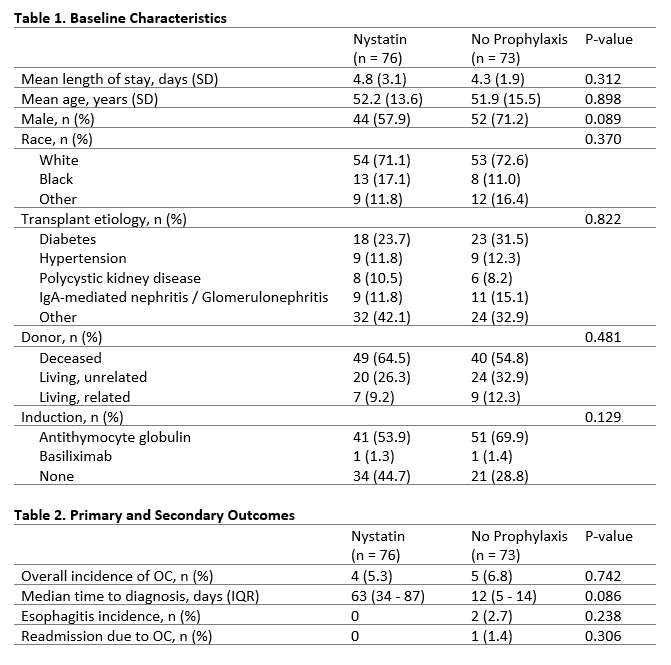Comparison of Oropharyngeal Candidiasis Outcomes in Renal Transplant Recipients Receiving Nystatin or No Antifungal Prophylaxis
Pharmacy, University of Michigan, Michigan Medicine, Ann Arbor, MI
Meeting: 2020 American Transplant Congress
Abstract number: 65
Keywords: Efficacy, Fungal infection, Kidney transplantation, Post-operative complications
Session Information
Session Name: Antimicrobial & Diagnostic Stewardship in Transplantation
Session Type: Oral Abstract Session
Date: Saturday, May 30, 2020
Session Time: 3:15pm-4:45pm
 Presentation Time: 4:03pm-4:15pm
Presentation Time: 4:03pm-4:15pm
Location: Virtual
*Purpose: Oropharyngeal candidiasis (OC) rate in the absence of antifungal prophylaxis has been reported as low as 7.4% after renal transplant. Due to perceived low rates of OC and unavailability of nystatin during a national shortage, our center began to withhold any type of antifungal prophylaxis after renal transplant. The objective of this study was to compare the incidence of OC in patients receiving no prophylaxis versus nystatin.
*Methods: This single-center retrospective chart review compared adult renal transplant recipients (RTRs) receiving either nystatin oral suspension 500,000 units four times daily for 30 days or no antifungal prophylaxis. Patients were transplanted between July 2018 and September 2019 and received maintenance immunosuppression of tacrolimus, mycophenolate with or without prednisone. Patients were excluded if they received systemic antifungal treatment for any indication other than OC or died within 3 months of transplant. The primary outcome was the incidence of OC within 3 months of transplant, with a non-inferiority margin of 15% and a power of 90%. Secondary outcomes included time to OC occurrence and severity of OC.
*Results: There were 149 RTRs who met inclusion criteria. Two groups were well matched for baseline characteristics. [Table 1] In the no prophylaxis group, 5 of 73 RTRs (6.8%) developed OC within 3 months post-transplant, compared to 4 of 76 RTRs (5.3%) in the nystatin group (p = 0.742). There was a difference of +1.6% (95% CI -6.2 to 9.4%) in OC rate in the no prophylaxis group. The median time to OC was 63 days (IQR 34 – 87) in the nystatin group and 12 days (IQR 5 – 14) in the no prophylaxis group (p = 0.086). Two of the 5 infected RTRs in the no prophylaxis group developed EGD-confirmed esophagitis compared to none in the nystatin prophylaxis group. All RTRs with OC achieved symptom resolution with fluconazole (n = 8) or nystatin (n = 1). Only 1 RTR in the no prophylaxis group required readmission due to thrush. [Table 2]
*Conclusions: In this single-center retrospective study, the absence of antifungal prophylaxis was non-inferior to 30-day nystatin prophylaxis at reducing the incidence of OC within 3 months post-transplant. Although not statistically significant, the median time to OC was shorter in the no prophylaxis group than in the nystatin group. All patients who developed OC, including the two RTRs with esophagitis in the no prophylaxis group, had resolution of infection with treatment. A larger randomized, controlled trial is needed to evaluate the absolute benefit of antifungal prophylaxis in RTRs.
To cite this abstract in AMA style:
Ky TQ, Cotiguala L, Fitzgerald L, McMurry K, Park J, Tischer S. Comparison of Oropharyngeal Candidiasis Outcomes in Renal Transplant Recipients Receiving Nystatin or No Antifungal Prophylaxis [abstract]. Am J Transplant. 2020; 20 (suppl 3). https://atcmeetingabstracts.com/abstract/comparison-of-oropharyngeal-candidiasis-outcomes-in-renal-transplant-recipients-receiving-nystatin-or-no-antifungal-prophylaxis/. Accessed December 24, 2025.« Back to 2020 American Transplant Congress

